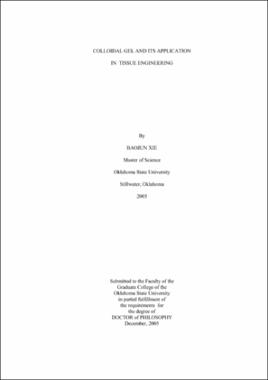| dc.contributor.advisor | Smay, James E. | |
| dc.contributor.author | Xie, Baojun | |
| dc.date.accessioned | 2013-11-26T08:31:43Z | |
| dc.date.available | 2013-11-26T08:31:43Z | |
| dc.date.issued | 2005-12 | |
| dc.identifier.uri | https://hdl.handle.net/11244/7174 | |
| dc.description.abstract | Scope and Method of Study: Three dimensional, porous polymer scaffolds are fabricated by direct writing of colloidal gels. This work focuses on both the processing of colloidal gel and assembly of the scaffold structures as well as characterization of cytotoxicity and protein release kinetics. Specifically, rheological and elastic properties of the colloidal gels are probed as a function of solids loading and binder concentration. Porous scaffolds are characterized by optical and electron microscopy. In vitro studies include cell mortality after six weeks culture on passive scaffolds, model protein release profiles from scaffolds, and quantitative measurement of protein activity upon release from the scaffolds by chemotaxis. | |
| dc.description.abstract | Findings and Conclusions: The polymer colloidal gels formulated with acrylic latex particles and Pluronic F127 copolymer binder have pseudoplastic with yield stress rheology. Increases in solids loading and Pluronic concentration cause increased viscosity, elastic modulus, and yield stress. The rheology and rapid recovery of yield allow for flow through a deposition nozzle of the direct write tool and rapid setting of the extrudate to maintain the deposited structure. Scaffolds with a wide variety of porosity are fabricated. Because of the aqueous and low temperature nature of the process, bioactive molecules such as proteins are readily incorporated into the scaffold either in their original form or encapsulated in chitosan nanoparticles and subsequently released without denaturation and in a controlled fashion. Protein release rate is dependent on both the degree of coalescence of the scaffold material and the molecular weight of the chitosan nanoparticles. Protein inclusion and subsequent release is demonstrated using BSA and PDGF-BB. The scaffolds fabricated are non-cytotoxic as confirmed by QEC6 cell culture. Heterogeneous scaffolds with localized regions of dissolved species are demonstrated to illustrate the capability to assembly scaffolds with functional gradients or segregated zones. | |
| dc.format | application/pdf | |
| dc.language | en_US | |
| dc.rights | Copyright is held by the author who has granted the Oklahoma State University Library the non-exclusive right to share this material in its institutional repository. Contact Digital Library Services at lib-dls@okstate.edu or 405-744-9161 for the permission policy on the use, reproduction or distribution of this material. | |
| dc.title | Colloidal gel and its application in tissue engineering | |
| dc.contributor.committeeMember | Johannes, A. J. | |
| dc.contributor.committeeMember | Rhinehart, Russell R. | |
| dc.contributor.committeeMember | Ford, Warren T. | |
| osu.filename | Xie_okstate_0664D_1572.pdf | |
| osu.accesstype | Open Access | |
| dc.type.genre | Dissertation | |
| dc.type.material | Text | |
| thesis.degree.discipline | Chemical Engineering | |
| thesis.degree.grantor | Oklahoma State University | |
